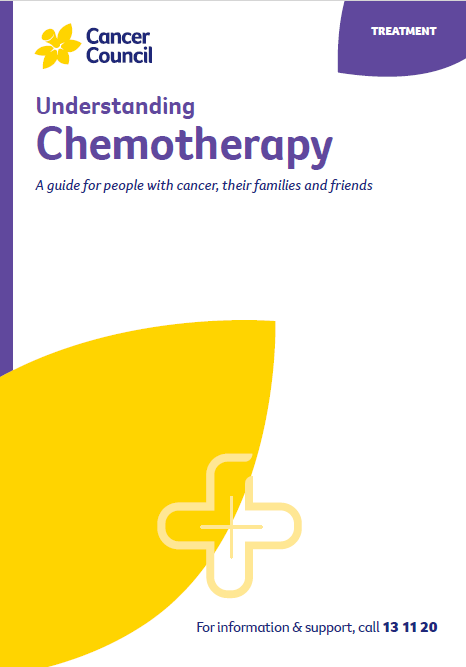- Home
- Non-Hodgkin lymphoma
- Treatment
- Chemotherapy
Chemotherapy for non-Hodgkin lymphoma
Chemotherapy is the use of drugs to kill cancer cells or slow their growth.
Learn more about:
- How it is used
- Ways to have chemotherapy
- Having chemotherapy
- Side effects of chemotherapy
- Taking care with infections
- Video: What is chemotherapy?
- Podcast: Making Treatment Decisions
How it is used
Chemotherapy can be used in various ways depending on the grade and type of non-Hodgkin lymphoma.
Chemotherapy can be used on its own or in combination with other drugs, such as steroids, monoclonal antibodies and immunotherapy drugs. Your haematologist or medical oncologist will talk to you about the combination of drugs they recommend for you.
Ways to have chemotherapy
Intravenous chemotherapy
Chemotherapy drugs are usually given as a liquid through a drip inserted into a vein (intravenous infusion). The drugs may be injected through a cannula, which is a small plastic tube inserted in a vein, or through a type of central venous access device (CVAD).
The type of device used will depend on how often you need chemotherapy, how long it will take to give each dose and the length of time you will be having chemotherapy.
Central venous access device
This is a thin plastic tube that remains in the vein throughout the course of treatment. Common types include:
- PICC (peripherally inserted central catheter) – a thin tube that is inserted into the upper arm
- port-a-cath (port) – a small device that is surgically inserted under the skin of the chest or arm to give access to the veins
- central line (central venous catheter or CVC) – a thin tube with several openings that is inserted into a vein in the neck or chest.
Oral chemotherapy
Some chemotherapy drugs for non-Hodgkin lymphoma are given as tablets you swallow.
Intrathecal chemotherapy
Occasionally, chemotherapy is given into the fluid around the spinal cord through a lumbar puncture. Having drugs this way is called intrathecal chemotherapy, and it is done to prevent or treat non-Hodgkin lymphoma in the brain or spinal cord.
Having chemotherapy
You will usually have a combination of drugs spread over 4–6 months. The drug combination and treatment schedule will depend on the type of non-Hodgkin lymphoma. Usually, chemotherapy is given over a few days, followed by a rest period of a few weeks. This is called a cycle. The rest period lets the blood counts return to normal.
Throughout treatment, you will be closely monitored by your doctor and you will have tests to see how well the chemotherapy drugs are working.
As chemotherapy can reduce the number of blood cells in your body, you will have regular blood tests to check your blood count, and your liver and kidney function. You may also be given injections of a drug known as granulocyte-colony stimulating factor (G-CSF). This helps increase your white blood cell count and protect you from infection.
Chemotherapy treatment may be repeated several times, even if tests show that the cancer is in remission after 2 or 3 cycles.
For more on this, see our general section on Chemotherapy.
→ READ MORE: Side effects of chemotherapy
I considered briefly not having chemotherapy, as I had heard how awful it was. I’m glad I changed my mind because, while it’s different for everyone, for me it was life-saving and managed well by the treatment team.
Sheridan
Video: What is chemotherapy?
Watch this short video to learn more about chemotherapy.
Podcast: Making Treatment Decisions
Listen to more episodes from our podcast for people affected by cancer
More resources
Dr Puja Bhattacharyya, Haematology Staff Specialist, Western Sydney Local Health District, Blacktown Hospital; A/Prof Christina Brown, Haematologist, Royal Prince Alfred Hospital and The University of Sydney; Dr Susan Carroll, Senior Staff Specialist, Radiation Oncology, Royal North Shore Hospital and The University of Sydney; Jo Cryer, Clinical Nurse Consultant, Haematology, St George Hospital; Marie Marr, Consumer; Katelin Mayer, Clinical Nurse Consultant, Cancer Outreach Team, Nelune Comprehensive Cancer Centre, Sydney; Vanessa Saunders, 13 11 20 Consultant, Cancer Council NSW; Elise Toyer, Haematology Clinical Nurse Consultant, Blacktown Hospital.
View the Cancer Council NSW editorial policy.
View all publications or call 13 11 20 for free printed copies.

